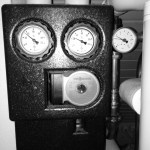After my experience with my heating system I have made a lot of progress. Unfortunately, I must admit, that I have given up on trying to get the data directly out of my heating system. From my tries I learned that there seem to be no protocols or defined interfaces. So for me this was the core challenge. Not the connection to the cloud, but the lack of standard to get the data out of the machine itself. Manufacturers seem to be quite protective, even so they have no own way to use the data. But I had no time for reverse engineering. So I had to do things the hard way: I put my own sensors to the solar system and simulated the switches via potential-free outputs. The integration into a cloud from here was surprisingly simple. For me, this was of course just a hobby. To get fault reports and switch the heating from “Not at home” to “At home” is no more than a gimmick for me. And now I can also see how much heat my photothermal device provides. On my current vacation I realized, however, that this does not provide real added value for me. Because what can I actually do when I see from Bangkok that my heating system is broken?

An optimized service is a competitive advantage
For our customers the situation is quite different. For them it is an opportunity to earn more money and reduce operating costs while delivering a significantly better service.
-
Getting info even before the customer notice an issue:
While the installation looks OK, the right sensors will show you an upcoming issue.
From my acquired data I can see some trends in efficiency. Our customers need to dig a bit more into the data, but if you see an increasing parameter in the current status of a motor while all other parameters stay the same, there is definitely a problem coming up. Using your knowledge on the machine and the history of failures it’s possible to predict what part causes the issue and sometimes even how long it would take till its failure.
-
Plan next service visit:
I have a yearly service interval on my heating system. Decreasing efficiency for me means I have to pay more money for natural gas instead of benefitting from the “free of charge” solar energy. So I invest the money of e.g. clearing the solar panels even so the next service is not due.
Imagine the negative effect is not a few 100th of Euro a year but failing means several 1000th Euros an hour. If you can avoid this and change an unplanned defect to a planned service this saves a lot of money.
-
Have the right spare part available:
If you know which machine part will fail or in the worst case have failed already, you can take the adequate spare part with you.
Like many others, my washing machine failed a while ago. When service arrived he had a spare water pump with him. The main issue: It was not the water pump failing but the controller output. And he had no spare controller with him.
So longer time to get the machine back on duty and I had to pay more money for the repair.
The same thing happens to automation customers, not for washing machines, but for more important installations.
The hierarchy of maintenance types
To illustrate the possibilities of an intelligent use of sensor technology and analytics tools, Ingo Schwarzer , Chief Technology Officer ( CTO ) at DB Systel outlined at this year’s ” CIO & IT Executive Summit ” the four maturity levels of maintenance and repair services :
-
The simplest – and riskiest – form is the “Reactive Maintenance” : An error message occurs, is picked up ( What happens and where?) and will be worked off.
-
For the “Preventive Maintenance” there are fixed maintenance intervals . If a problem occurs in between it will cost a lot of money – not to mention the loss of image. It is therefore important to select thoughtful service cycles and to optimize to ratio between service costs and chance of loss.
-
In order to optimize this radio companies can introduce “Predictive Maintenance“. This uses the collected behavioral data of the machines of a certain type from sensors or other data acquisition devices, to answer the following question: Which systems should be serviced or replaced with a certain urgency, because they would otherwise fail within the next maintenance cycle?
-
The most advanced form is the “Maintenance Optimization”. This goes one step further, by – for example – determined in the case of competing failure reports, which should be processed first because potential consequences outweigh the other. As the term implies, a system of Maintenance Optimization helps the company to continuously improve its maintenance strategy.
Which maintenance type are you?


{{comment.comment}}